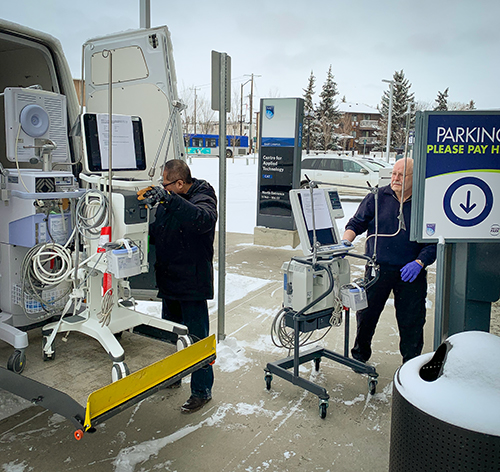“When the request comes, there’s no time to wait”
When the call came, NAIT was ready. In fact, staff in the School of Health and Life Sciences had started getting ready a week earlier.
On the morning of March 31, Alberta Health Services picked up the 24 ventilators it had asked to borrow from NAIT. The ventilators are used by students in Respiratory Therapy labs and in the polytechnic’s Simulation Centre.
“We knew, watching other countries, that ventilators were going to be needed,” says Kerri Oshust (Medical Radiologic Technology ’99), director of the Simulation Centre.
“We knew, watching other countries, that ventilators were going to be needed.”
For that reason, she and her team had started looking at what it would take to mobilize their machines for clinical use before a formal request ever arrived. “You anticipate the need so you’re ready for it,” says Oshust. “When the request comes, there’s no time to wait.”
The nature of the need
Ventilators are machines that move air in and out of the lungs of patients who struggle to do that on their own. This is particularly important given the nature of the pandemic. A COVID-19 infection can result in severe respiratory distress. Though a relatively small percentage of patients experience symptoms bad enough to require a ventilator, the sheer number of infections worldwide has placed the machines in high demand.
 To help meet needs as they evolve, AHS contacted NAIT’s emergency operation centre – which had been activated in response to the pandemic – about access to the polytechnic’s ventilators. They are, after all, of the same quality as, and often identical to, those in clinical settings, even though they’re not used by real patients on campus.
To help meet needs as they evolve, AHS contacted NAIT’s emergency operation centre – which had been activated in response to the pandemic – about access to the polytechnic’s ventilators. They are, after all, of the same quality as, and often identical to, those in clinical settings, even though they’re not used by real patients on campus.
While Oshust coordinated the logistics of the loan, she says the “boots on the ground” were worn by biomedical technologists Diana Bendall (Biomedical Engineering Technology ’14), Michael Lewis (Biomedical Engineering Technology ’15) and Jinchul Shin, and Respiratory Therapy educational lab tech Cliff Reeves.
The team created an inventory of NAIT’s stock of ventilators and determined which units were appropriate to lend. For each, they created a list of technical requirements and passed that along to AHS.
“We needed a simplified process so AHS could get them up and running as quickly as possible.”
Pulling together to do our part
AHS will prepare the ventilators to be used on live patients before deploying them to health-care centres across the province. Over the coming weeks, they may become fixtures in emergency rooms and cardiac and intensive care units across Alberta.
It’s conceivable that, in some cases, they’ll end up back in the hands of the grads who learned their skills in the School of Health and Life Sciences, and quite possibly enable them to save lives.
“It’s not a question of ‘Should we?’ If we can, let’s help.”
“Most of the staff in our school come from professional experience in the health system, so we know what it’s like when there is a communicable disease outbreak, epidemic or pandemic," says dean Denise MacIver (Medical X-Ray Technology ’69), who was working at the Royal Alexandra Hospital when the SARS outbreak unfolded in 2003.
“So, to be able to help, it’s not a question of ‘Should we?’ If we can, let’s help.”
MacIver credits her team with the effort it took to make that happen. “They immediately rolled up their sleeves and did it,” she says. “And they did it well.”
Oshust echoes MacIver’s sentiments about being in a position to lend a hand. For her, it was “really important to … help the community, and to do our part.
“Especially at this time, everyone needs to contribute what they can and where they can. We’re all in this together.”